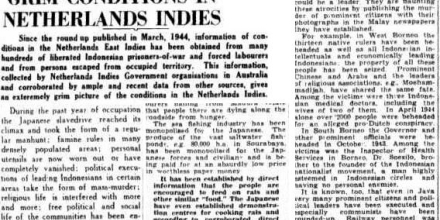Missing millions: The victims of Java's 1944-45 famine

Event details
Indonesia Study Group
Date & time
Venue
Speaker
Contacts
Join in-person: Hedley Bull Seminar Room 3, Hedley Bull Building, 130 Garran Rd, Acton ACT 2601
Join online: bit.ly/indonesia-study-group-2023
About the seminar
This presentation examines the human toll of the famine in Indonesia’s main island of Java during the cropping year 1944-45. In September 1951, Indonesian foreign minister Subardjo at the San Francisco conference to conclude an international peace treaty with Japan stated that the Japanese occupation caused ‘the loss of life of approximately four million people’. Although public knowledge at the time, this estimate soon disappeared from view. Indonesia’s historiography of the human toll of the 1942-1945 Japanese occupation years still focuses on the plight of the 2.1 million romusha forced labourers of whom at least 200,000 perished. It largely ignores the victims of the 1944-45 famine.
The presentation traces the origins of the estimate of 4 million victims to an extrapolation of administrative data on births and deaths recorded in Java during 1941-1945. It substantiates that these data were largely underestimated to the degree that they under-recorded births and infant mortality. The presentation re-estimates the 1941-1951 birth and mortality rates for the Indonesian population in Java. It approximates a net loss of population during the Japanese occupation years 1942-1945 of 3.4 million people. The mortality rates indicate that this included 1.9 million excess deaths; 0.7 during 1944 and 1.2 million during 1945. The residual 1.5 million were missing births, related to the decreased birth rates in 1944 and 1945, associated with the malnutrition of women of childbearing ages and the physical separation of wives from husbands recruited by the Japanese authorities to work as romusha.
The presentation then analyses the likely reasons why the millions of victims of the 1944-45 famine went missing from Indonesia’s public memory and historiography during the 1950s and 1960s. In the 1950s associations of surviving romusha self-organised and kept the public memory of their fate alive. But opportunities to draw attention to the fate of the famine victims seem to have fallen victim to silence and censorship. Silence in the context of the 1952-1958 Indonesia-Japan negotiations about the 1958 war reparations agreement. And censorship after President Sukarno abolished the elected parliament and seized power in March 1957.
About the speaker
Pierre van der Eng is Associate Professor and Reader in International Business and Business History at ANU Research School of Management. His areas of research specialisation include international business and the business and economic history of Indonesia. Among other topics, he published articles on long-term economic growth, population growth, food supply, mining, Chinese entrepreneurship, and the development of the stock exchange in Indonesia.










